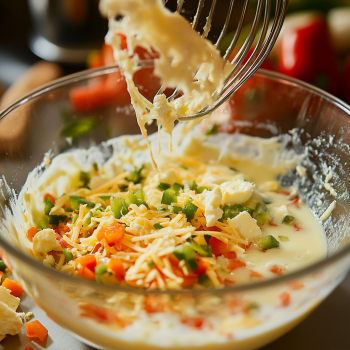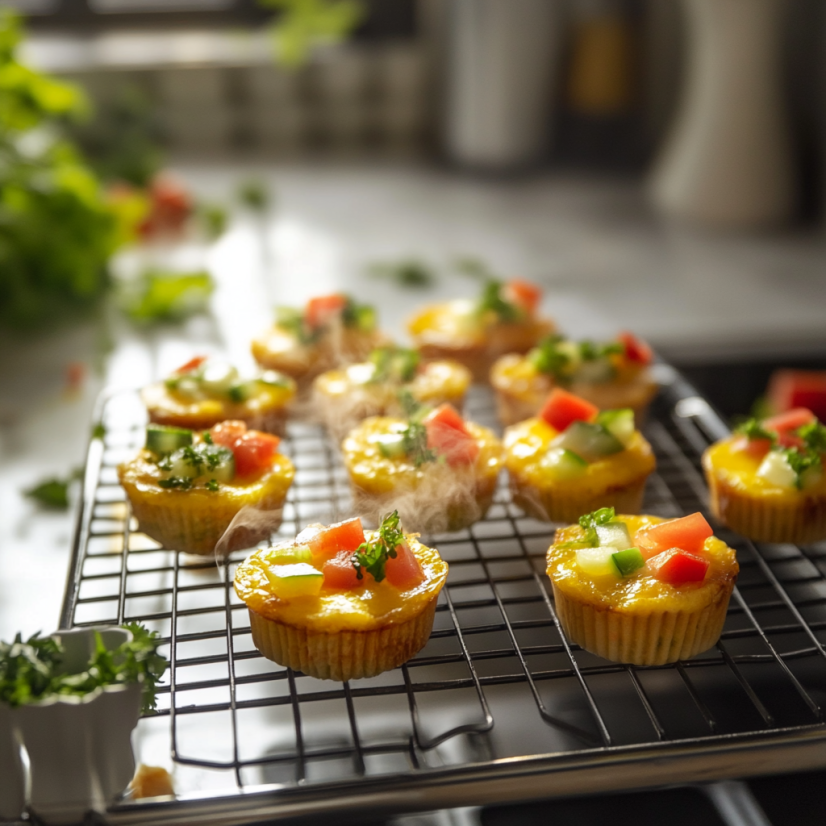Egg bites have become a breakfast favorite for their convenience, flavor, and versatility. However, for many home cooks, achieving the perfect soft and fluffy texture can feel like cracking a secret code. If you’ve ever taken a bite of your homemade egg creation only to discover it’s rubbery and tough, you’re not alone.
This article dives into the common pitfalls, scientific explanations, and practical solutions to transform your egg bites from rubbery to restaurant-quality. From understanding what causes this textural mishap to exploring step-by-step techniques for success, we’ve got you covered. Ready to rescue your egg bites? Let’s get started.
Table of Contents
Understanding the Problem
What Are Egg Bites and Why Do They Sometimes Turn Rubbery?
Egg bites are essentially a compact, flavorful combination of eggs, dairy, and add-ins like cheese, veggies, or meats. They’re a favorite for meal preppers and busy households alike. But when the texture goes wrong, they lose their appeal. Instead of being light and airy, rubbery egg bites can feel like chewing on a tasteless sponge.
The main culprit? Overcooking or incorrect preparation techniques. Eggs are highly sensitive to heat, and when exposed to too much or uneven heat, their proteins tighten excessively, leading to that undesirable rubbery texture.
Science Behind Egg Textures: Overcooking and Protein Reactions
Here’s the science behind it: Eggs are primarily composed of proteins and water. When heated, the proteins begin to coagulate, transforming the liquid into a firm structure. But there’s a fine line—apply too much heat, and the proteins bind too tightly, squeezing out moisture and creating a rubbery texture.
This reaction is particularly noticeable in egg bites because they often contain additional ingredients like cheese and milk. These add-ins can help retain moisture, but they also increase the chances of uneven cooking if not incorporated properly.
To avoid this, understanding the role of temperature and technique is key. Cooking eggs at a lower, steady temperature allows the proteins to set gently, resulting in soft, tender bites rather than rubbery lumps.
Common Mistakes When Preparing Egg Bites
Using the Wrong Cooking Method
Cooking methods play a massive role in the texture of egg bites. Baking, steaming, and microwaving all have different effects on how eggs set. For instance, baking egg bites at too high a temperature can overcook the outer layer, leaving it rubbery while the inside remains undercooked. On the other hand, microwaving often causes uneven cooking, resulting in tough patches.
To avoid these issues, it’s crucial to match your cooking method to the tools and ingredients you’re using. A slow, gentle heat works best for maintaining tenderness. Techniques like sous vide, which use precise temperature control, are particularly effective for egg-based dishes. These methods ensure even cooking, so your bites stay soft and flavorful.
Improper Ingredient Ratios
Another common error involves the balance of ingredients. While eggs are the star, add-ins like milk, cheese, and vegetables are crucial for achieving a creamy texture. Overloading the mixture with dense ingredients like cheddar cheese or overusing flour can result in rubbery, heavy bites.
For perfect egg bites, stick to a simple ratio: two parts egg to one part liquid (like milk or cream). Avoid heavy, starchy ingredients unless the recipe calls for them specifically. Mixing the ingredients thoroughly is also key to preventing dense pockets that ruin texture.

For more on balancing flavors and ingredients, check out this recipe for cottage cheese egg flatbread, which combines protein and moisture for a perfect bite.
How to Avoid Rubbery Egg Bites
Cooking Techniques for Perfect Egg Bites
Achieving the perfect egg bite comes down to technique. Low, slow cooking at even temperatures ensures the proteins in the eggs don’t tighten too much. Sous vide is a favorite method for many because it cooks the mixture evenly at a precise temperature, locking in moisture.
If sous vide isn’t an option, consider baking your egg bites in a water bath. Placing a pan of water on the oven rack beneath your muffin tray helps maintain a humid cooking environment, preventing dryness and rubbery textures.
Choosing the Right Equipment
Your equipment matters more than you might think. Silicone molds are excellent for preventing sticking and ensuring even heat distribution. Metal muffin tins can sometimes overcook the edges, so if you’re using them, consider greasing them well or lining them with parchment cups.
For microwaving, an egg cooker designed for uniform heating can be a game changer. These tools help avoid the hot spots that lead to tough textures. If you’re reheating, use methods that mimic gentle cooking, like steaming or oven warming.
Tips for Consistency in Ingredients and Cooking
A smooth, uniform mixture is essential. Whisk your eggs thoroughly, ensuring all ingredients are evenly distributed. Straining the mixture through a fine-mesh sieve before cooking can eliminate bubbles and clumps.
When adding vegetables, sauté them first to remove excess moisture. Too much water can dilute the egg mixture, affecting its ability to set properly. As for cheeses, opt for softer, milder varieties like Monterey Jack or goat cheese for a smoother texture.
By following these tips, you’ll transform your egg bites from rubbery disappointments into soft, velvety creations that rival any café version. For more ideas on combining flavors, explore this simple recipe for 3-ingredient banana bread, which emphasizes balance and simplicity in baking.
Reheating Egg Bites Without Ruining Them

Why Reheating Can Make Egg Bites Rubbery
Reheating is often where perfectly good egg bites lose their appeal. Many people rely on microwaves for convenience, but this method tends to unevenly heat the egg bites, creating dry and rubbery textures. This happens because microwaves quickly zap the moisture out of the food, especially when reheated without proper precautions.
Frozen egg bites are particularly susceptible to texture changes during reheating. Freezing alters the moisture content, and when combined with quick, high-heat reheating methods, it often results in overcooked or dried-out bites.
Best Practices for Reheating Egg Bites
To maintain the soft, creamy texture of your egg bites, reheating them slowly and with moisture is essential. Here are some foolproof methods:
- Steam Reheating: Place the egg bites in a heatproof dish, cover it with foil, and steam them gently over simmering water. The steam helps restore moisture, leaving the bites tender.
- Oven Reheating: Wrap the egg bites in foil with a small splash of water and warm them in a preheated oven at 300°F. This method evenly distributes heat without overcooking.
- Microwave with Water: If the microwave is your only option, place a small cup of water in the microwave alongside the egg bites. This generates steam and helps retain moisture during reheating.
When reheating frozen egg bites, allow them to thaw overnight in the refrigerator first. This prevents uneven reheating and reduces the risk of a rubbery texture.
For other practical ideas on reheating baked dishes, you might find inspiration from our Pineapple Cake Recipe, which emphasizes maintaining moisture in baked goods.
FAQ Section
Why Do My Egg Bites Deflate After Cooking?
Deflation is a common issue with egg-based dishes, caused by air incorporated during mixing. As the egg bites cool, the air pockets shrink, resulting in a flatter appearance. To prevent this, mix your ingredients gently and avoid over-whipping. Cooking at a lower temperature also helps stabilize the structure.
Can I Fix Rubbery Egg Bites After They’re Cooked?
Unfortunately, once egg bites become rubbery, their texture cannot be fully reversed. However, you can salvage the dish by adding a creamy sauce or gravy to reintroduce moisture. Reheating them gently with a bit of butter or oil can also make them more palatable.
What’s the Ideal Temperature for Cooking Egg Bites?
Cooking egg bites at 325°F to 350°F provides the best results. Lower temperatures allow the eggs to set gradually, preventing overcooking and maintaining a tender texture. For those using sous vide, 172°F is the sweet spot.
For additional tips on maintaining consistency in your recipes, check out our guide to Baked Cottage Cheese Flatbread, which emphasizes precise cooking techniques for achieving the perfect texture.
Additional Tips and Tricks for Delicious Egg Bites
Experimenting With Flavors While Maintaining Texture
Creating flavorful egg bites doesn’t mean sacrificing their texture. The key is balance. Adding herbs like parsley or chives and spices like paprika can elevate your bites without adding bulk that might make them rubbery. For a flavor-packed twist, consider folding in sautéed veggies like spinach, mushrooms, or bell peppers, ensuring they’re cooked to remove excess water.
Cheese lovers can experiment with soft options like feta or cream cheese, which melt beautifully into the egg mixture. Avoid overloading your bites with heavy cheeses like cheddar unless grated finely, as they can weigh down the eggs.
For inspiration, check out this Cottage Cheese Egg Flatbread Recipe, which combines protein and light flavors for a well-rounded dish.
Storage and Freezing: Keeping Egg Bites Fresh
Egg bites are ideal for meal prep, but storing them incorrectly can lead to dryness or that dreaded rubbery texture. After cooling completely, wrap each bite tightly in plastic wrap or place them in airtight containers. This prevents freezer burn and retains moisture.
To freeze, lay the bites on a baking sheet and freeze them individually before transferring them to a sealed freezer bag. This method keeps them from sticking together. Use within three months for the best texture.
When ready to eat, thaw the bites overnight in the fridge and follow the reheating tips mentioned earlier. Freezing doesn’t have to compromise quality if done carefully!
Conclusion and Final Thoughts
Whether you’re a seasoned chef or a home cook just starting, the question Why are my egg bites rubbery? doesn’t have to remain a mystery. By understanding the science behind eggs, avoiding common mistakes, and using the right tools and techniques, you can create soft, fluffy bites every time.
Remember, the texture of your egg bites depends on a few key factors: using gentle, even heat, balancing your ingredients, and reheating them carefully. Once you’ve mastered these basics, the possibilities for flavor combinations are endless. From classic bacon and cheddar to creative options like sundried tomato and goat cheese, you can turn this simple dish into a gourmet treat.
Looking to try other easy and delicious recipes? Explore our Oreo Mug Cake Recipe for another quick and satisfying meal-prep option.
By following these tips, your egg bites will be anything but rubbery—guaranteed! Ready to give them a try? Don’t forget to share your creations and experiment with new flavors. Happy cooking!
Creative Ways to Serve Egg Bites
Pairing Egg Bites With Side Dishes
Egg bites may be the star, but the right side dishes can turn them into a complete meal. Pairing them with fresh fruit like sliced avocado or a tangy citrus salad provides a refreshing balance to their rich flavors. In addition, for something heartier, serve them with toasted whole-grain bread or a light side of sautéed greens.
On the other hand, if you’re preparing egg bites for brunch, consider adding crispy bacon or roasted potatoes to the plate. These sides add contrasting textures and ensure a satisfying, well-rounded meal. For a creative twist, try dipping your egg bites into a mild salsa or creamy hollandaise sauce.
Nutritional Content (Per 100g)
Egg bites are a nutritious option for any meal, offering a balance of protein and essential nutrients. Here’s a breakdown of their nutritional profile:
| Nutrient | Amount per 100g |
|---|---|
| Calories | 150 kcal |
| Protein | 10 g |
| Fat | 10 g |
| Carbohydrates | 2 g |
| Fiber | 0.5 g |
| Sodium | 300 mg |
| Cholesterol | 200 mg |
Serving Egg Bites for Different Occasions
Egg bites are incredibly versatile and fit seamlessly into various occasions. For example, for a grab-and-go breakfast, pack them in a container with a handful of cherry tomatoes or baby carrots. Moreover, if you’re hosting a brunch, arrange the bites on a platter, garnished with fresh herbs, for an eye-catching display.
Additionally, for a kid-friendly snack, cut the egg bites into smaller pieces and pair them with crackers or cheese cubes. With these ideas in mind, your egg bites can go beyond the breakfast table and become a hit at any event.
Looking for more ways to enhance your dishes? Check out this Savory Steak Delight Recipe for pairing ideas that focus on balancing flavors.
Troubleshooting Common Egg Bite Issues
Why Are My Egg Bites Rubbery?
One of the most frequently asked questions is, Why are my egg bites rubbery? The main reasons are overcooking, uneven heating, and improper ingredient ratios. Thus, rubberiness occurs when the proteins in the eggs bind too tightly, squeezing out moisture and leaving the bites tough. Addressing these issues with proper techniques, as outlined in earlier sections, ensures soft, tender results every time.
How Can I Prevent Overcooking?
Preventing overcooking starts with understanding your cooking method. For instance, use a low, consistent heat setting and avoid rushing the process. Baking at 325°F to 350°F or using a sous vide machine ensures even cooking without overheating. In addition, checking the bites a few minutes before the recipe’s suggested cook time is also helpful. Look for a firm center that jiggles slightly—this means they’re perfectly done.
Can Ingredients Affect Texture?
Yes! The balance of ingredients plays a significant role in the final texture. However, too many heavy or watery add-ins, like cheese or raw vegetables, can alter the consistency. Always sauté vegetables beforehand and opt for lighter cheeses to avoid weighing down the mixture.
For more kitchen tips and insights, explore recipes like the Seafood Pasta with Linguine and Shrimp, which balance ingredients beautifully for a perfect dish.inguine and Shrimp, which balance ingredients beautifully for a perfect dish.

